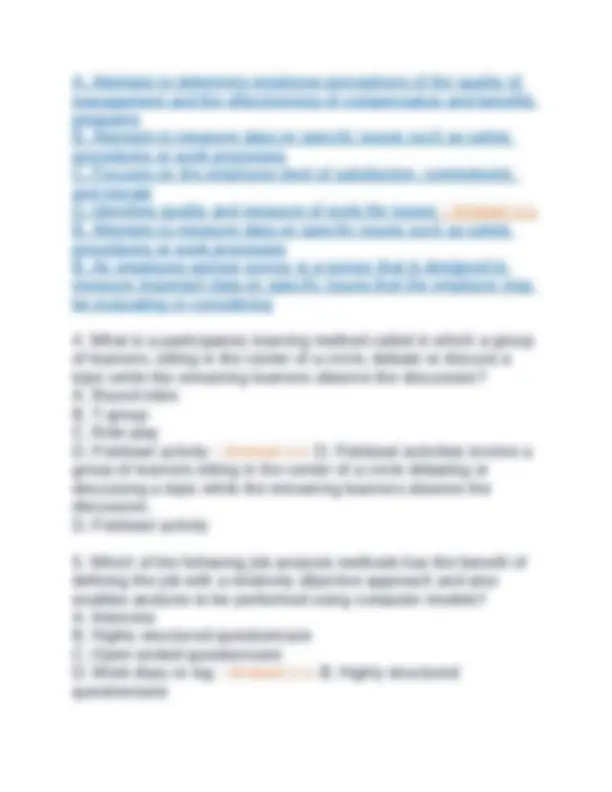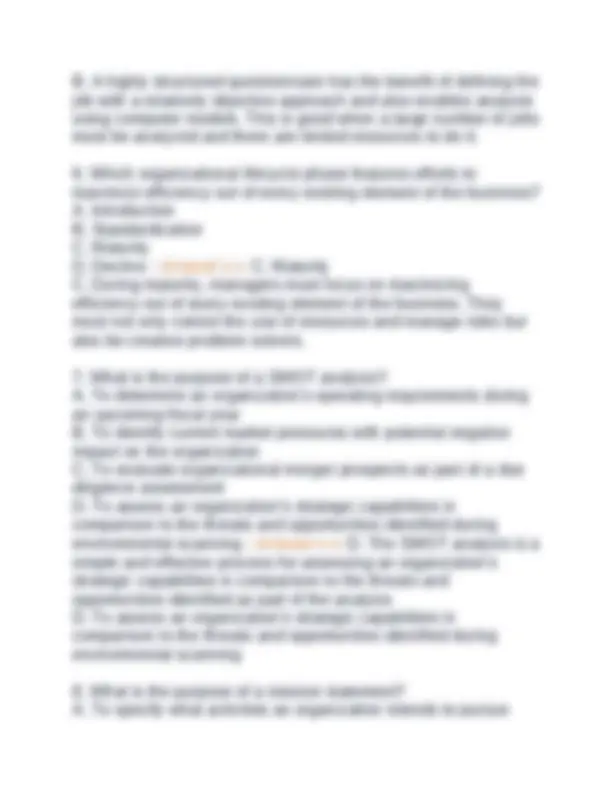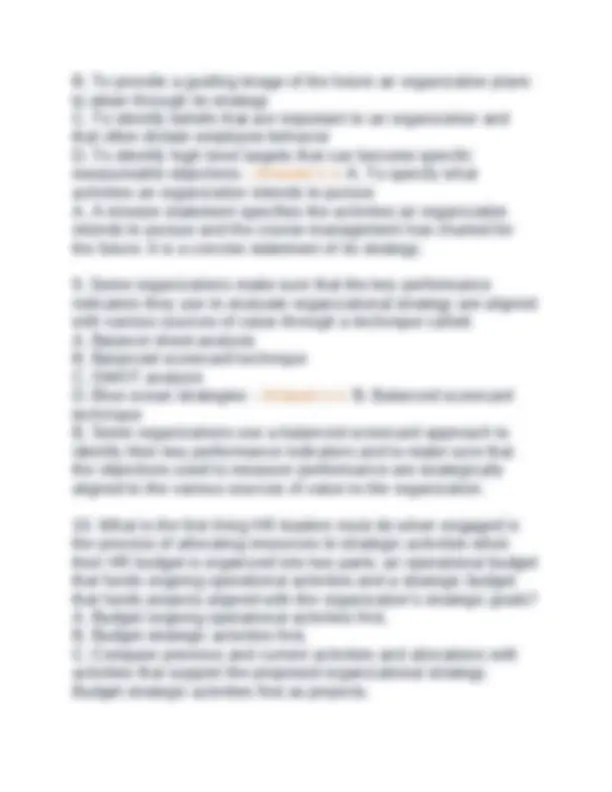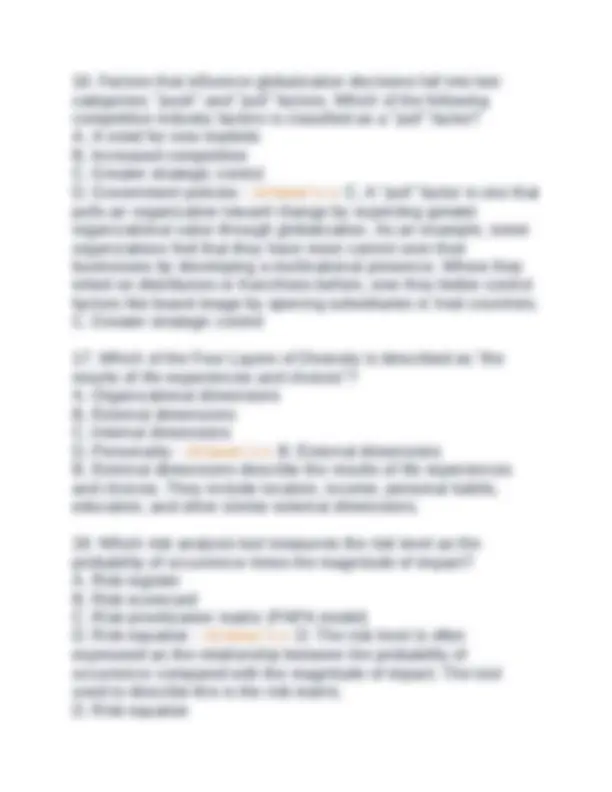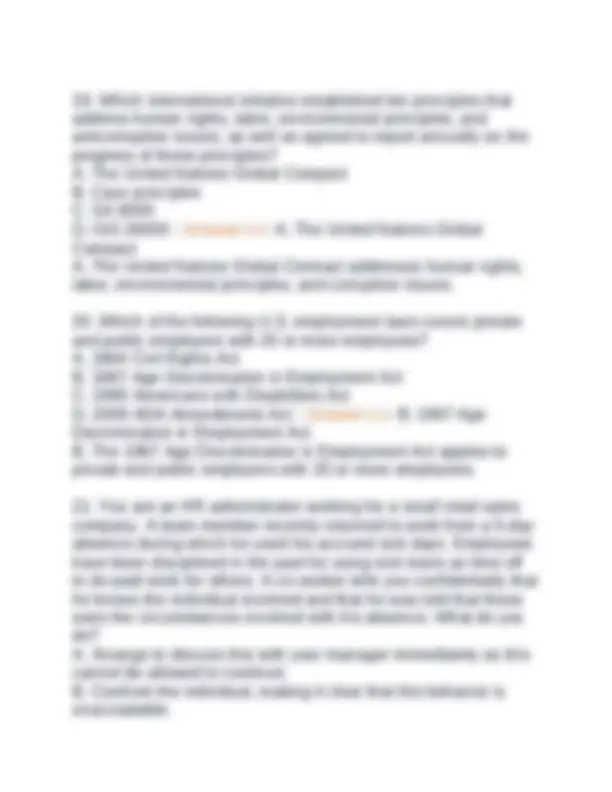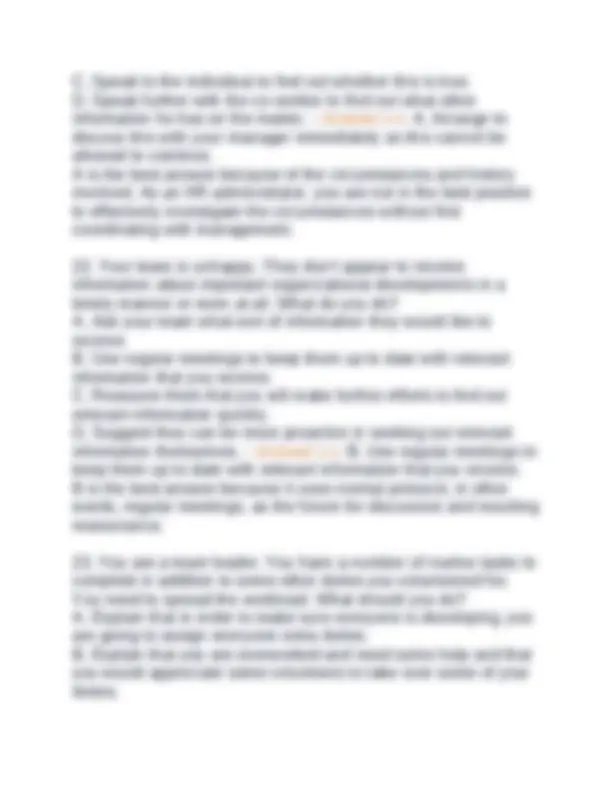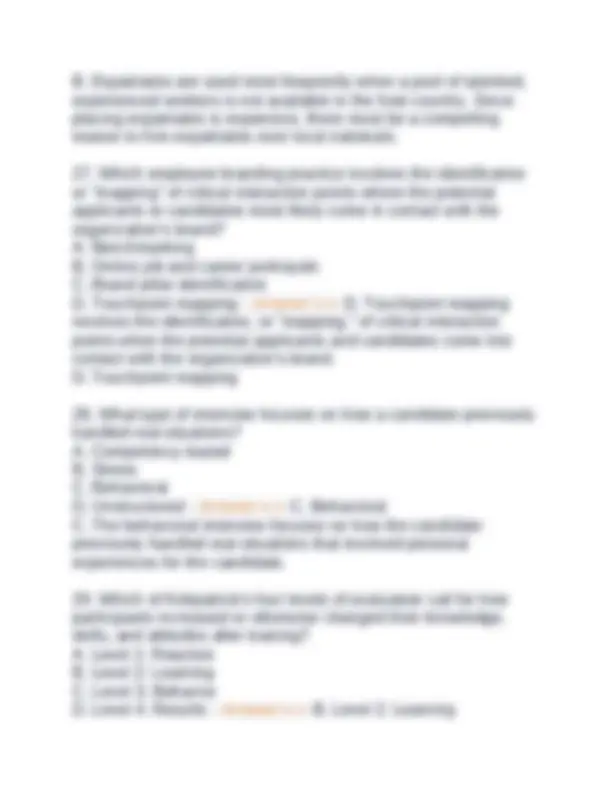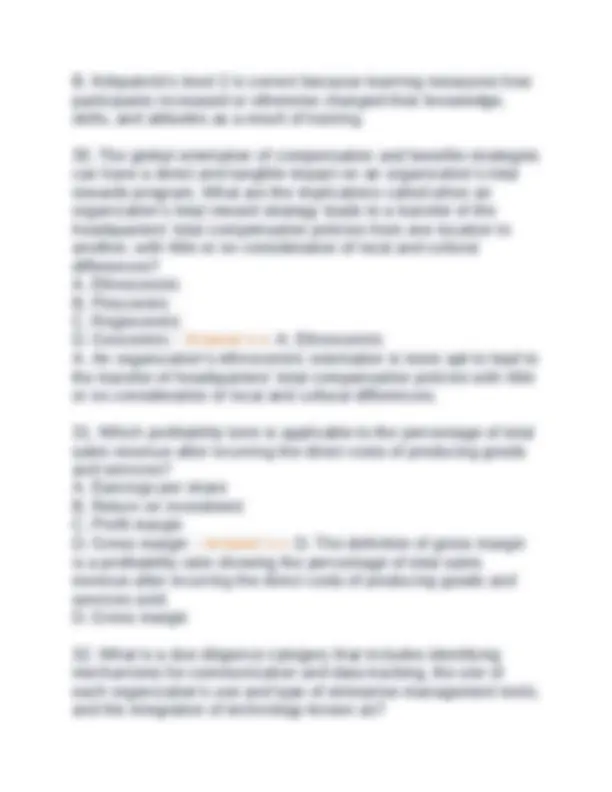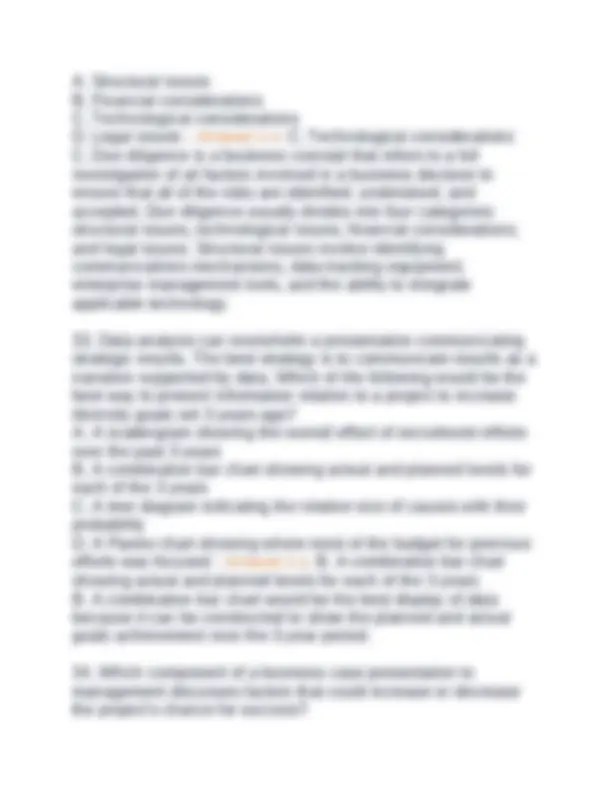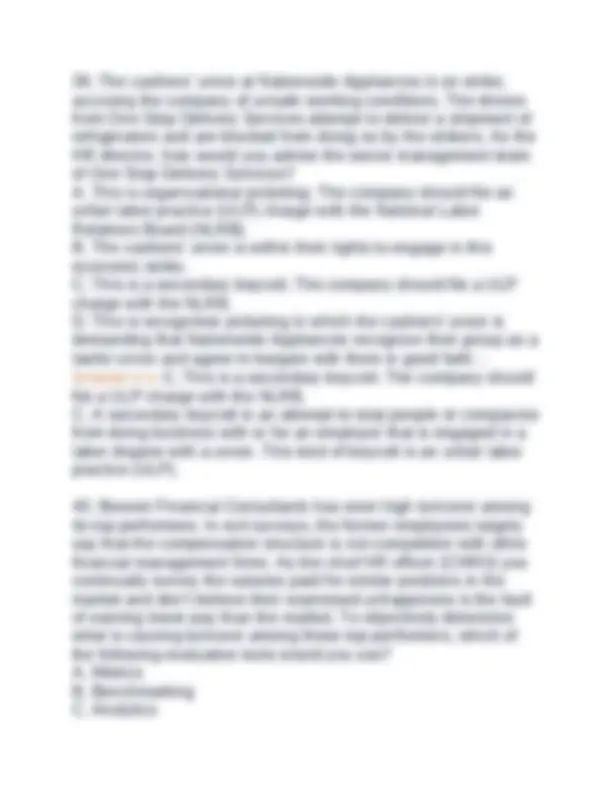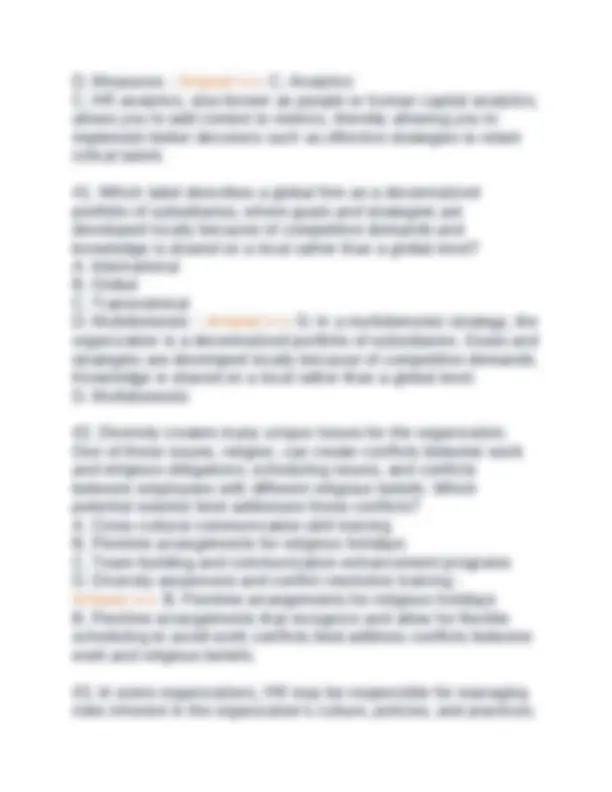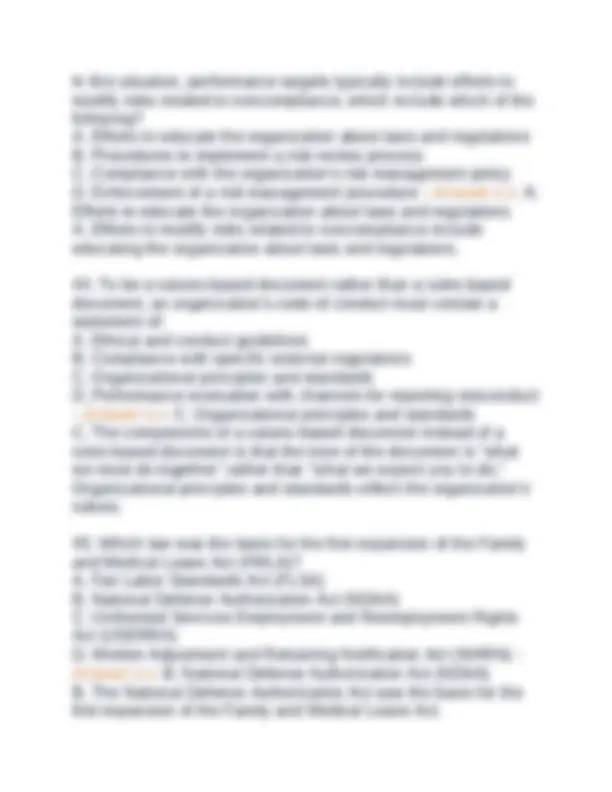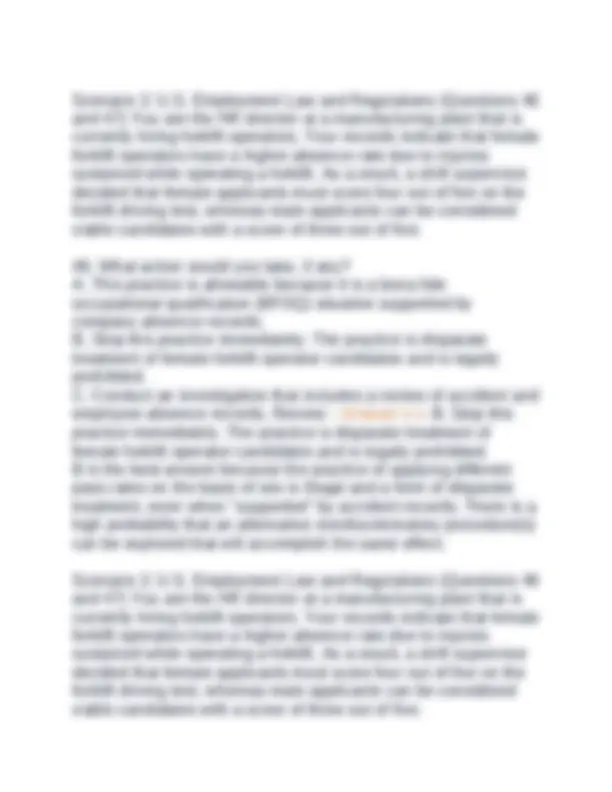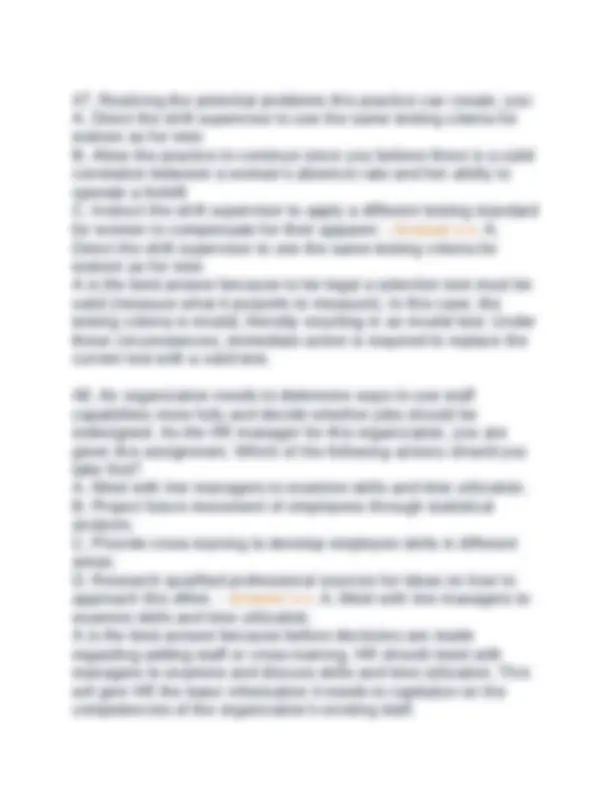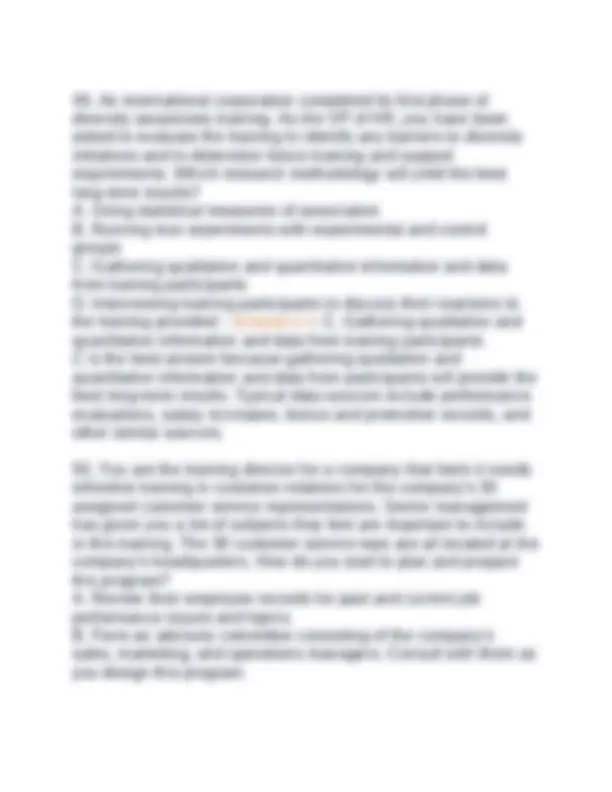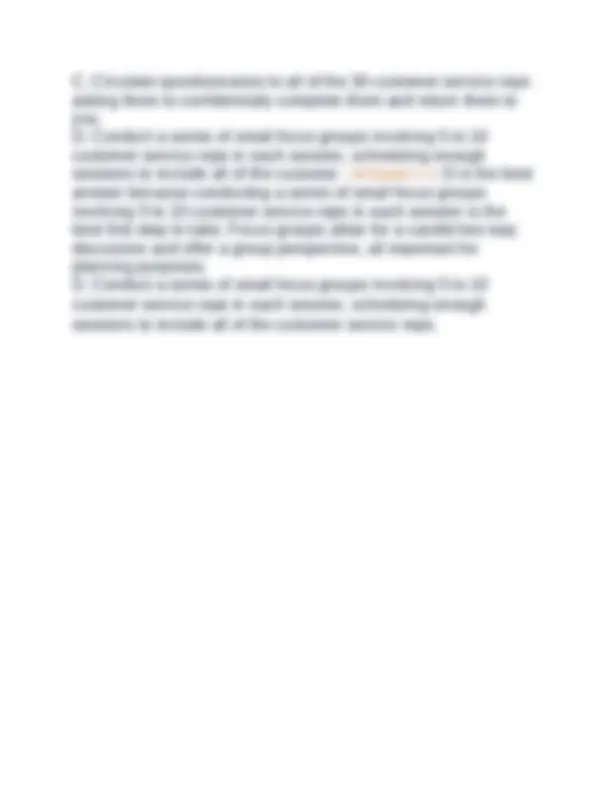Download Employee Engagement and Performance Management and more Exams Human Resource Management in PDF only on Docsity!
SHRM Chapter 1 Pre-assessment Test SHRM-
CP and SHRM-SCP Review Questions and
Answers 100% Pass | Graded A+
David Mungai [Date] [Course title]
SHRM Chapter 1 Pre-assessment Test
SHRM-CP and SHRM-SCP Review
Questions and Answers 100% Pass |
Graded A+
- One of the key PEST factors that can influence an organization's global talent acquisition and retention strategies is the following question: Do tax and other socialized incentives exist that could influence hiring decisions? This factor is identified as: A. Political B. Economic C. Social D. Technological - Answer>> A. Political A. The factor that addresses whether tax or other socialized incentives exist that could influence hiring decisions is a political factor.
- What is behavioral engagement? A. The inherent personality-based elements that make an individual predisposed to being engaged B. Workplace conditions or practices that can be improved through organizational interventions under management's control C. The effort employees put into their jobs, which leads to greater value D. When employees appear engaged but do not feel or think in an engaged way - Answer>> C. The effort employees put into their jobs, which leads to greater value C. Behavioral engagement is evident in the effort employees put into their jobs, which leads to greater value, creating higher performance from their less-engaged counterparts.
- An employee opinion survey is a survey that:
B. A highly structured questionnaire has the benefit of defining the job with a relatively objective approach and also enables analysis using computer models. This is good when a large number of jobs must be analyzed and there are limited resources to do it.
- Which organizational lifecycle phase features efforts to maximize efficiency out of every existing element of the business? A. Introduction B. Standardization C. Maturity D. Decline - Answer>> C. Maturity C. During maturity, managers must focus on maximizing efficiency out of every existing element of the business. They must not only control the use of resources and manage risks but also be creative problem solvers.
- What is the purpose of a SWOT analysis? A. To determine an organization's operating requirements during an upcoming fiscal year B. To identify current market pressures with potential negative impact on the organization C. To evaluate organizational merger prospects as part of a due diligence assessment D. To assess an organization's strategic capabilities in comparison to the threats and opportunities identified during environmental scanning - Answer>> D. The SWOT analysis is a simple and effective process for assessing an organization's strategic capabilities in comparison to the threats and opportunities identified as part of the analysis D. To assess an organization's strategic capabilities in comparison to the threats and opportunities identified during environmental scanning
- What is the purpose of a mission statement? A. To specify what activities an organization intends to pursue
B. To provide a guiding image of the future an organization plans to attain through its strategy C. To identify beliefs that are important to an organization and that often dictate employee behavior D. To identify high-level targets that can become specific measureable objectives - Answer>> A. To specify what activities an organization intends to pursue A. A mission statement specifies the activities an organization intends to pursue and the course management has charted for the future. It is a concise statement of its strategy.
- Some organizations make sure that the key performance indicators they use to evaluate organizational strategy are aligned with various sources of value through a technique called: A. Balance sheet analysis B. Balanced scorecard technique C. SWOT analysis D. Blue ocean strategies - Answer>> B. Balanced scorecard technique B. Some organizations use a balanced scorecard approach to identify their key performance indicators and to make sure that the objectives used to measure performance are strategically aligned to the various sources of value to the organization.
- What is the first thing HR leaders must do when engaged in the process of allocating resources to strategic activities when their HR budget is organized into two parts: an operational budget that funds ongoing operational activities and a strategic budget that funds projects aligned with the organization's strategic goals? A. Budget ongoing operational activities first. B. Budget strategic activities first. C. Compare previous and current activities and allocations with activities that support the proposed organizational strategy. Budget strategic activities first as projects.
B. Critical incident C. Field review D. Management by objectives (MBO) - Answer>> D. Management by objectives (MBO) is a type of performance appraisal where the employee sets objectives for themselves that are aligned to the company strategy. The objectives must be measureable. D. Management by objectives (MBO)
- Globally, what is the most common type of employment relationship? A. At-will for part-time staff only B. At-will C. Contractual D. Contractual for senior-level executives only - Answer>> C. Globally, excluding the United States, most employees have employment contracts. Even in the United States where the at-will doctrine is most common, there are numerous exceptions that have been established through litigation and nondiscrimination laws. C. Contractual
- Sail Fleet Shipping recently implemented a new HRIS. Which of the following describes a security measure the company should take to ensure protection of employees' personal data? A. Decode B. Decrypt C. Encrypt D. Convert - Answer>> C. Encryption is the technical term used to describe converting data into a format that hides its intended meaning. All employee data should be stored in this format to protect employee privacy and personal information C. Encrypt
- Factors that influence globalization decisions fall into two categories: "push" and "pull" factors. Which of the following competitive industry factors is classified as a "pull" factor? A. A need for new markets B. Increased competition C. Greater strategic control D. Government policies - Answer>> C. A "pull" factor is one that pulls an organization toward change by expecting greater organizational value through globalization. As an example, some organizations find that they have more control over their businesses by developing a multinational presence. Where they relied on distributors or franchises before, now they better control factors like brand image by opening subsidiaries in host countries. C. Greater strategic control
- Which of the Four Layers of Diversity is described as "the results of life experiences and choices"? A. Organizational dimensions B. External dimensions C. Internal dimensions D. Personality - Answer>> B. External dimensions B. External dimensions describe the results of life experiences and choices. They include location, income, personal habits, education, and other similar external dimensions.
- Which risk analysis tool measures the risk level as the probability of occurrence times the magnitude of impact? A. Risk register B. Risk scorecard C. Risk prioritization matrix (PAPA model) D. Risk equation - Answer>> D. The risk level is often expressed as the relationship between the probability of occurrence compared with the magnitude of impact. The tool used to describe this is the risk matrix. D. Risk equation
C. Speak to the individual to find out whether this is true. D. Speak further with the co-worker to find out what other information he has on the matter. - Answer>> A. Arrange to discuss this with your manager immediately as this cannot be allowed to continue. A is the best answer because of the circumstances and history involved. As an HR administrator, you are not in the best position to effectively investigate the circumstances without first coordinating with management.
- Your team is unhappy. They don't appear to receive information about important organizational developments in a timely manner or even at all. What do you do? A. Ask your team what sort of information they would like to receive. B. Use regular meetings to keep them up to date with relevant information that you receive. C. Reassure them that you will make further efforts to find out relevant information quickly. D. Suggest they can be more proactive in seeking out relevant information themselves. - Answer>> B. Use regular meetings to keep them up to date with relevant information that you receive. B is the best answer because it uses normal protocol, in other words, regular meetings, as the forum for discussion and resulting reassurance.
- You are a team leader. You have a number of routine tasks to complete in addition to some other duties you volunteered for. You need to spread the workload. What should you do? A. Explain that in order to make sure everyone is developing, you are going to assign everyone extra duties. B. Explain that you are overworked and need some help and that you would appreciate some volunteers to take over some of your duties.
C. Explain that you are looking for volunteers to take on some additional responsibilities, which is an opportunity for learning. D. Explain that you are going to assign everyone extra duties in order to make the team more effective. - Answer>> C is the best answer because it preserves the team leader authority while addressing the situation. C. Explain that you are looking for volunteers to take on some additional responsibilities, which is an opportunity for learning. Scenario 1: Relationship Management (Questions 24 and 25) You manage an extremely busy team of six people who are your organization's HR department. The November to December period is the busiest time of the year. December is approaching, and your department is undoubtedly beginning to feel the strain. Matters are reaching the breaking point. Staff morale is dropping, people are getting frustrated, and errors are increasing. Your staff is openly questioning what is expected of them. They seem confused about the department's overall objectives. However, the situation is not irretrievable if you act now. Complaints from company management and staff have not yet significantly increased. Urgent action is required.
- What actions would you take under these circumstances? A. Set up weekly meetings with your team to review department status; set up some short-term objectives. B. Inform the team that there is too much car - Answer>> A. Set up weekly meetings with your team to review department status; set up some short-term objectives. A. This is a situation that needs immediate action. A is the best answer because it involves establishing short-term objectives that are urgently needed under these circumstances. These objectives, in turn, are best supported by the enhanced communications that will result from the weekly meetings.
B. Expatriates are used most frequently when a pool of talented, experienced workers is not available in the host country. Since placing expatriates is expensive, there must be a compelling reason to hire expatriates over local nationals.
- Which employee branding practice involves the identification or "mapping" of critical interaction points where the potential applicants or candidates most likely come in contact with the organization's brand? A. Benchmarking B. Online job and career portrayals C. Brand pillar identification D. Touchpoint mapping - Answer>> D. Touchpoint mapping involves the identification, or "mapping," of critical interaction points when the potential applicants and candidates come into contact with the organization's brand. D. Touchpoint mapping
- What type of interview focuses on how a candidate previously handled real situations? A. Competency-based B. Stress C. Behavioral D. Unstructured - Answer>> C. Behavioral C. The behavioral interview focuses on how the candidate previously handled real situations that involved personal experiences for the candidate.
- Which of Kirkpatrick's four levels of evaluation call for how participants increased or otherwise changed their knowledge, skills, and attitudes after training? A. Level 1: Reaction B. Level 2: Learning C. Level 3: Behavior D. Level 4: Results - Answer>> B. Level 2: Learning
B. Kirkpatrick's level 2 is correct because learning measures how participants increased or otherwise changed their knowledge, skills, and attitudes as a result of training.
- The global orientation of compensation and benefits strategies can have a direct and tangible impact on an organization's total rewards program. What are the implications called when an organization's total reward strategy leads to a transfer of the headquarters' total compensation policies from one location to another, with little or no consideration of local and cultural differences? A. Ethnocentric B. Polycentric C. Regiocentric D. Geocentric - Answer>> A. Ethnocentric A. An organization's ethnocentric orientation is more apt to lead to the transfer of headquarters' total compensation policies with little or no consideration of local and cultural differences.
- Which profitability term is applicable to the percentage of total sales revenue after incurring the direct costs of producing goods and services? A. Earnings per share B. Return on investment C. Profit margin D. Gross margin - Answer>> D. The definition of gross margin is a profitability ratio showing the percentage of total sales revenue after incurring the direct costs of producing goods and services sold. D. Gross margin
- What is a due diligence category that includes identifying mechanisms for communication and data tracking, the use of each organization's use and type of enterprise management tools, and the integration of technology known as?
A. Statement of need B. Recommended solution C. Risks and opportunities D. Estimated costs and timeframe - Answer>> C. Risks and opportunities C. Risk and opportunities discuss outcomes that could decrease or increase the project's chance of success. Outcomes can also present new opportunities that call for action; they also create risks of doing nothing.
- Which of the following is a characteristic of an income statement? A. Provides a "bottom-line" look at how the organization is performing B. Compares assets, liabilities, and equities C. Includes investments the company has made D. Includes long-term debt - Answer>> A. Provides a "bottom- line" look at how the organization is performing A. The bottom line is the relationship between revenue and expenses that equates to a company's net income, or the bottom line. This is data that is reflected on an income statement.
- Senior leadership of a retail store chain is considering reducing the number of managers. What should be considered when determining which areas could be effectively managed with fewer supervisors? A. Which stores have the lowest financial performance? B. Do the employees perform repetitive simple tasks or is the work complex? C. Which stores are unionized? D. What is the highest level of education completed by the current management staff? - Answer>> B. Do the employees perform repetitive simple tasks or is the work complex? B. A wide span of control works best when the employees perform repetitive or simple tasks. For more complex, specialized
functions, a narrow span of control is more fitting. The problem that senior leadership is trying to solve in this case is whether they can reduce management staff without negatively impacting employee supervision. It would make sense to look at the pros and cons of adjusting spans of control.
- Which of the following is an organizational effectiveness and development (OED) intervention that facilitates the discovery of causes and development of solutions with critical input from those most closely involved? A. Producing sustainable results B. Supporting continuous improvement C. Strategically aligned D. Collaborative - Answer>> D. Collaborative is the OED intervention that facilitates discovery of causes and development of solutions with critical input from those most closely involved. D. Collaborative
- Which type of alternative staffing arrangement involves circumstances in which an organization transfers all or substantially all of its employees to the payroll of an employee leasing firm; the leasing firm leases the employees back to the organization while handling most of the HR administrative functions? A. Professional employer organization (PEO) B. Payrolling C. Temp-to-lease program D. Outsourced services - Answer>> A. Professional employer organization (PEO) A. A professional employer organization (PEO) is a firm that hires employees from other organizations with the intent of leasing them back to the original organization while providing all or most of the HR administrative services support to these leased employees for a fee
D. Measures - Answer>> C. Analytics C. HR analytics, also known as people or human capital analytics, allows you to add context to metrics, thereby allowing you to implement better decisions such as effective strategies to retain critical talent.
- Which label describes a global firm as a decentralized portfolio of subsidiaries, where goals and strategies are developed locally because of competitive demands and knowledge is shared on a local rather than a global level? A. International B. Global C. Transnational D. Multidomestic - Answer>> D. In a multidomestic strategy, the organization is a decentralized portfolio of subsidiaries. Goals and strategies are developed locally because of competitive demands. Knowledge is shared on a local rather than a global level. D. Multidomestic
- Diversity creates many unique issues for the organization. One of these issues, religion, can create conflicts between work and religious obligations, scheduling issues, and conflicts between employees with different religious beliefs. Which potential solution best addresses these conflicts? A. Cross-cultural communication-skill training B. Flextime arrangements for religious holidays C. Team-building and communication-enhancement programs D. Diversity awareness and conflict resolution training - Answer>> B. Flextime arrangements for religious holidays B. Flextime arrangements that recognize and allow for flexible scheduling to avoid work conflicts best address conflicts between work and religious beliefs.
- In some organizations, HR may be responsible for managing risks inherent in the organization's culture, policies, and practices.
In this situation, performance targets typically include efforts to modify risks related to noncompliance, which include which of the following? A. Efforts to educate the organization about laws and regulations B. Procedures to implement a risk review process C. Compliance with the organization's risk management policy D. Enforcement of a risk management procedure - Answer>> A. Efforts to educate the organization about laws and regulations A. Efforts to modify risks related to noncompliance include educating the organization about laws and regulations.
- To be a values-based document rather than a rules-based document, an organization's code of conduct must contain a statement of: A. Ethical and conduct guidelines B. Compliance with specific external regulations C. Organizational principles and standards D. Performance evaluation with channels for reporting misconduct
- Answer>> C. Organizational principles and standards C. The components of a values-based document instead of a rules-based document is that the tone of the document is "what we must do together" rather than "what we expect you to do." Organizational principles and standards reflect the organization's values.
- Which law was the basis for the first expansion of the Family and Medical Leave Act (FMLA)? A. Fair Labor Standards Act (FLSA) B. National Defense Authorization Act (NDAA) C. Uniformed Services Employment and Reemployment Rights Act (USERRA) D. Worker Adjustment and Retraining Notification Act (WARN) - Answer>> B. National Defense Authorization Act (NDAA) B. The National Defense Authorization Act was the basis for the first expansion of the Family and Medical Leave Act.

